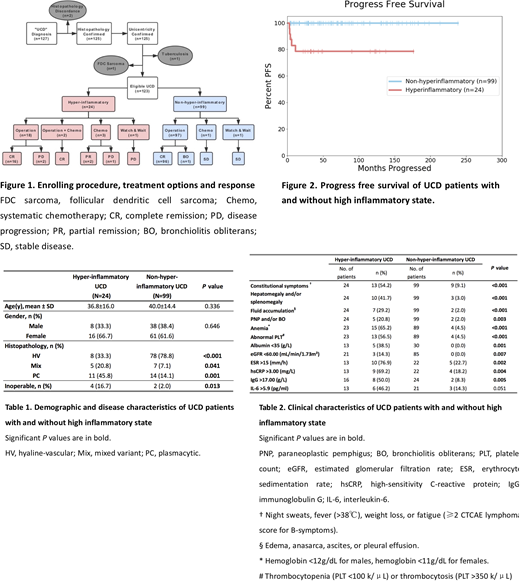Objective: Castleman disease (CD) is a group of rare lymphoproliferative disorders which are divided into unicentric CD (UCD) and multicentric CD (MCD) according to the number of lymph node regions involved. In the case of UCD, no or only local compressive symptoms are present with normal biochemistry, and prognosis is great after complete surgical resection. However, we have noticed that a small portion of UCD patients presenting with severe constitutional symptoms accompanied by high inflammatory state might resemble MCD in clinical presentations and biochemical features. Since our current understanding of this group of patients is far from enough, we are here to summarize the characteristics, treatments and outcomes of these high inflammatory patients and compare them with other UCD patients to see whether surgery still serves well as first-line treatment, so as to illuminate the biological behavior of these hyper-inflammatory UCD patients.
Method: We retrospectively analyzed 123 cases of UCD diagnosed between Jan 2000 and Dec 2019 in Peking Union Medical College Hospital. The patients with high inflammatory state who met the laboratory and clinical criteria for idiopathic MCD (Blood, 2017) were included in the hyper-inflammatory group (Figure 1). We summarized their clinical characteristics, treatments and outcomes. Response criteria of iMCD defined by Castleman Disease Collaborative Network (CDCN) were cited to evaluate treatment response in symptoms and biochemistry. Kaplan-Meier analysis were used to analyze the progress-free survival (PFS) and overall survival (OS), and comparison was made with other UCD patients through Log-rank test.
Result: Among 24 UCD patients with high inflammatory state (19.5%), when compared to others without, constitutional symptoms, organomegaly, fluid retention and complication of paraneoplastic pemphigus (PNP) or bronchiolitis obliterans (BO) were more common. ESR or CRP elevation, anemia, abnormal platelet count, albumin decrease, renal function impairment and IgG increase were also more usually discovered (Table 1). Meanwhile, plasmacytic (PC) histopathology was more frequently seen (45.8% vs 14.1%, P=0.001) (Table 2), but no statistical significance was shown on the lymph node region involved. As for first-line treatments (Figure 1), 18 UCD patients with high inflammatory state (75.0%) underwent complete surgical excision alone; there was no recurrence of lymphadenopathy after surgery, and the inflammation resolved completely except 2 cases of disease progression (both complicated by PNP), achieving a response rate of 88.9%. 2 patients (8.3%) received chemotherapy together with surgery, and all disease completely resolved. Among the 3 patients (12.5%) treated only with chemotherapy, 1 experienced symptomatic and biochemical progression of disease. Finally, there was one patient (4.17%), after a watch-and-wait period, experienced progression in symptoms. In contrast, disease progression was not seen in UCD without high inflammatory state. There was no statistical difference between median follow-up time of the two groups. UCD patients without high inflammatory state have a better PFS curve [P<0.001, HR=0.005 (95%CI: 0.001-0.043)], but median PFS was not reached in either group of patients (Figure 2). The overall survival was not significantly different between the two groups [P=0.225, HR=4.722 (95%CI: 0.123-181)].
Conclusion: UCD patients with high inflammatory state are not uncommon. Although they resemble MCD with more PC histopathology, more severe symptoms and abnormal lab results, the good response to surgical treatment suggested that patients with high inflammatory state still shared common biological behavior with other UCD. However, recurrence of symptoms and progression of inflammation might still happen in patients with PNP or unresectable disease, so treatment options other than surgery should be considered in these patients.
No relevant conflicts of interest to declare.
Author notes
Asterisk with author names denotes non-ASH members.


This feature is available to Subscribers Only
Sign In or Create an Account Close Modal